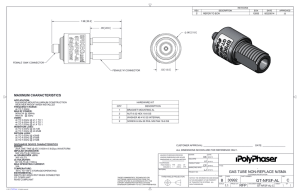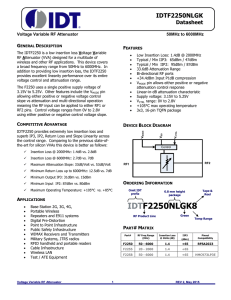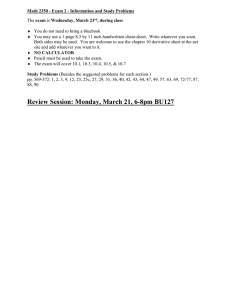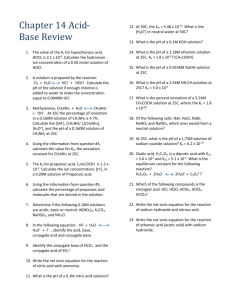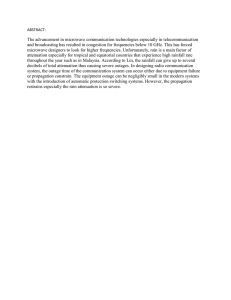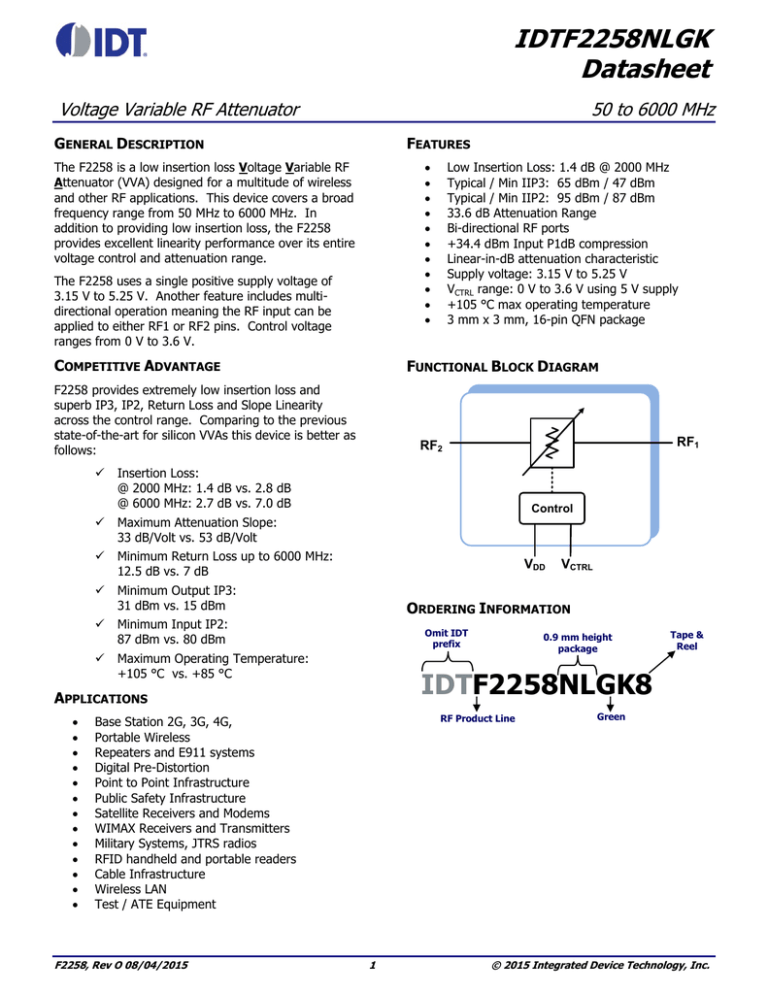
IDTF2258NLGK
Datasheet
Voltage Variable RF Attenuator
50 to 6000 MHz
GENERAL DESCRIPTION
FEATURES
The F2258 is a low insertion loss Voltage Variable RF
Attenuator (VVA) designed for a multitude of wireless
and other RF applications. This device covers a broad
frequency range from 50 MHz to 6000 MHz. In
addition to providing low insertion loss, the F2258
provides excellent linearity performance over its entire
voltage control and attenuation range.
The F2258 uses a single positive supply voltage of
3.15 V to 5.25 V. Another feature includes multidirectional operation meaning the RF input can be
applied to either RF1 or RF2 pins. Control voltage
ranges from 0 V to 3.6 V.
COMPETITIVE ADVANTAGE
FUNCTIONAL BLOCK DIAGRAM
F2258 provides extremely low insertion loss and
superb IP3, IP2, Return Loss and Slope Linearity
across the control range. Comparing to the previous
state-of-the-art for silicon VVAs this device is better as
follows:
Insertion Loss:
@ 2000 MHz: 1.4 dB vs. 2.8 dB
@ 6000 MHz: 2.7 dB vs. 7.0 dB
Maximum Attenuation Slope:
33 dB/Volt vs. 53 dB/Volt
Minimum Return Loss up to 6000 MHz:
12.5 dB vs. 7 dB
Minimum Output IP3:
31 dBm vs. 15 dBm
Minimum Input IP2:
87 dBm vs. 80 dBm
Maximum Operating Temperature:
+105 °C vs. +85 °C
Control
VDD
VCTRL
ORDERING INFORMATION
Omit IDT
prefix
0.9 mm height
package
Tape &
Reel
IDTF2258NLGK8
RF Product Line
Base Station 2G, 3G, 4G,
Portable Wireless
Repeaters and E911 systems
Digital Pre-Distortion
Point to Point Infrastructure
Public Safety Infrastructure
Satellite Receivers and Modems
WIMAX Receivers and Transmitters
Military Systems, JTRS radios
RFID handheld and portable readers
Cable Infrastructure
Wireless LAN
Test / ATE Equipment
F2258, Rev O 08/04/2015
RF1
RF2
APPLICATIONS
Low Insertion Loss: 1.4 dB @ 2000 MHz
Typical / Min IIP3: 65 dBm / 47 dBm
Typical / Min IIP2: 95 dBm / 87 dBm
33.6 dB Attenuation Range
Bi-directional RF ports
+34.4 dBm Input P1dB compression
Linear-in-dB attenuation characteristic
Supply voltage: 3.15 V to 5.25 V
VCTRL range: 0 V to 3.6 V using 5 V supply
+105 °C max operating temperature
3 mm x 3 mm, 16-pin QFN package
1
Green
© 2015 Integrated Device Technology, Inc.
F2258
ABSOLUTE MAXIMUM RATINGS
Parameter
Symbol
Min
Max
Units
VDD
-0.3
+5.5
V
VCTRL
-0.3
Minimum
(VDD, +4.0)
V
VRF
-0.3
0.3
V
PMAX24
30
dBm
Junction Temperature
Tj
150
°C
Storage Temperature Range
Tst
150
°C
260
°C
VDD to GND
VCTRL to GND (with 0 V ≤ VDD ≤ 5.25 V)
RF1, RF2 to GND
RF1 or RF2 Input Power applied for 24
hours maximum (VDD applied @ 2000 MHz
and Tcase=+85°C)
-65
Lead Temperature (soldering, 10s)
ElectroStatic Discharge – HBM
(JEDEC/ESDA JS-001-2012)
VESDHBM
(Class 1C)
ElectroStatic Discharge – CDM
(JEDEC 22-C101F)
VESDCDM
(Class C3)
Stresses above those listed above may cause permanent damage to the device. Functional operation of the device at
these or any other conditions above those indicated in the operational section of this specification is not implied.
Exposure to absolute maximum rating conditions for extended periods may affect device reliability.
PACKAGE THERMAL AND MOISTURE CHARACTERISTICS
θJA (Junction – Ambient)
80.6 °C/W
θJC (Junction – Case) [The Case is defined as the exposed paddle]
Moisture Sensitivity Rating (Per J-STD-020)
Voltage Variable RF Attenuator
5.1 °C/W
MSL1
2
Rev O 08/04/2015
F2258
F2258 RECOMMENDED OPERATING CONDITIONS
Parameter
Symbol
Supply Voltage
VDD
Control Voltage
VCTRL
Operating Temperature Range
TCASE
Frequency Range
RF Operating Power
Conditions
CW
Typ
3.15
Max
Units
5.25
V
VDD = 3.90 V to 5.25 V
0
3.6
VDD = 3.15 V to 3.90 V
0
VDD-0.3
-40
+105
°C
50
6000
MHz
See
Figure 1
dBm
Exposed Paddle
FRF
PMAX,
Min
Power can be applied
to RF1 or RF2
V
RF1 Port Impedance
ZRF1
Single Ended
50
Ω
RF2 Port Impedance
ZRF2
Single Ended
50
Ω
Figure 1 - MAXIMUM RF INPUT POWER VS. RF FREQUENCY
Rev O 08/04/2015
3
Voltage Variable RF Attenuator
F2258
F2258 SPECIFICATION
Refer to EVKit / Applications Circuit, VDD = +3.3 V, TCASE = +25 °C, signal applied to RF1 input, FRF = 2000 MHz,
minimum attenuation, PIN = 0 dBm for small signal parameters, +20 dBm for single tone linearity tests, +20 dBm per
tone for two tone tests, two tone delta frequency = 50 MHz, PCB board traces and connector losses are de-embedded
unless otherwise noted. Refer to Typical Operating Curves for performance over entire frequency band.
Parameter
Symbol
Supply Current
IDD
Control Current
ICTRL
Insertion Loss, IL
AMIN
Maximum Attenuation
Conditions
Min
1
0.90
-1.0
Minimum Attenuation
34
35
At 18 dB attenuation relative
to Insertion Loss
10
34.4
S11
S22
4
16
700 MHz
17
2000 MHz
17
6000 MHz
15
4
16
700 MHz
15
2000 MHz
16
6000 MHz
13
65
IIP3MIN
All attenuation settings
OIP3MIN
Maximum attenuation
35
PIN + IM2dBc,
IM2 term is F1+F2
95
All attenuation settings
87
IIP2
IIP2MIN
μA
dB
dB
Deg
IIP3
Input IP2
mA
ΦΔMID
50 MHz
Output IP3
1.40
10
1.9
27
50 MHz
Input IP3
1.17
At 36 dB attenuation relative
to Insertion Loss
Input 1dB Compression3
Minimum RF2 Return Loss
over control voltage range
Units
ΦΔMAX
Insertion Phase Δ
Minimum RF1 Return Loss
over control voltage range
Max
1.4
2
AMAX
Typ
44
55
dBm
dB
dB
dBm
dBm
dBm
Input IH2
HD2
PIN + H2dBc
90
dBm
Input IH3
HD3
PIN + (H3dBc/2)
54
dBm
Any 1 dB step in the 0 dB to
33 dB control range
50% VCTRL to RF settled to
within ± 0.1 dB
15
µs
Settling Time
Note 1:
Note 2:
Note 3:
Note 4:
TSETTL0.1dB
Items in min/max columns in bold italics are Guaranteed by Test.
Items in min/max columns that are not bold/italics are Guaranteed by Design Characterization.
The input 1dB compression point is a linearity figure of merit. Refer to Absolute Maximum Ratings section along with Figure 1 for the
maximum RF input power vs. RF frequency
Set blocking capacitors C1 & C2 to 0.01uF to achieve best return loss performance at 50 MHz.
Voltage Variable RF Attenuator
4
Rev O 08/04/2015
F2258
TYPICAL OPERATING CONDITIONS (TOC)
Unless otherwise noted for the TOC graphs on the following pages, the following conditions apply.
VDD = +3.3 V or +5.0 V
TCASE = +25 ºC
FRF = 2000 MHz
RF trace and connector losses are de-embedded for S-parameters
Pin = 0 dBm for all small signal tests
Pin = +20 dBm for single tone linearity tests (RF1 port driven)
Pin = +20 dBm/tone for two tone linearity tests (RF1 port driven)
Two tone frequency spacing = 50 MHz
Rev O 08/04/2015
5
Voltage Variable RF Attenuator
F2258
TYPICAL OPERATING CONDITIONS [BROADBAND PERFORMANCE] (- 1 -)
Attenuation vs. VCTRL
Attenuation vs. Frequency
0
0.7GHz
-5
1.5GHz
-10
Attenuation (dB)
2.7GHz
-10
Attenuation (dB)
0
0.4GHz
4.0GHz
5.0GHz
-15
-20
6.0GHz
-20
-30
-25
-30
-40
-35
-50
-40
0.0
0.2
0.4
0.6
0.8
1.0
1.2
1.4
1.6
1.8
2.0
2.2
2.4
0
2.6
Vctrl = 0.0V
Vctrl = 0.8V
Vctrl = 1.0V
Vctrl = 1.2V
Vctrl = 1.4V
Vctrl = 1.6V
Vctrl = 1.8V
Vctrl = 2.4V
1
2
3
4
5
6
7
8
9
Frequency (GHz)
VCTRL (V)
Min. & Max. Attenuation vs. Frequency
Attenuation Delta to 25C vs. Frequency
3.00
Attenuation Delta to 25C (dB)
2.50
2.00
-40C / 0.9GHz
-40C / 2.0GHz
-40C / 3.0GHz
105C / 0.9GHz
105C / 2.0GHz
105C / 3.0GHz
1.50
1.00
0.50
0.00
-0.50
-1.00
-1.50
-2.00
-2.50
-3.00
0.0
0.2
0.4
0.6
0.8
1.0
1.2
1.4
1.6
1.8
2.0
2.2
2.4
VCTRL (V)
Voltage Variable RF Attenuator
6
Rev O 08/04/2015
2.6
F2258
TYPICAL OPERATING CONDITIONS (- 2 -)
Attenuation vs. VCTRL
Attenuation Slope vs. VCTRL
0
Attenuation Slope (dB/V)
1.5GHz
2.7GHz
-10
4.0GHz
5.0GHz
-15
0.4GHz
45
0.7GHz
-5
Attenuation (dB)
50
0.4GHz
6.0GHz
-20
-25
-30
-35
0.7GHz
1.5GHz
40
2.7GHz
4.0GHz
35
5.0GHz
30
6.0GHz
25
20
15
10
5
0
-40
0.6
0.0 0.2 0.4 0.6 0.8 1.0 1.2 1.4 1.6 1.8 2.0 2.2 2.4 2.6
0.8
1.0
1.2
0
1.8
2.0
0
0.4GHz
0.7GHz
-5
2.2
1.5GHz
2.7GHz
-10
4.0GHz
5.0GHz
-15
0.4GHz
0.7GHz
-5
RF2 Return Loss (dB)
RF1 Return Loss (dB)
1.6
RF2 Return Loss vs. VCTRL
RF1 Return Loss vs. VCTRL
6.0GHz
-20
-25
-30
1.5GHz
2.7GHz
-10
4.0GHz
5.0GHz
-15
6.0GHz
-20
-25
-30
-35
-35
-40
-40
0.0
0.2
0.4
0.6
0.8
1.0
1.2
1.4
1.6
1.8
2.0
2.2
2.4
0.0
2.6
0.2
0.4
0.6
0.8
1.0
0.4GHz
2.0
2.2
2.4
2.6
0.4GHz
Insertion Phase Slope (deg/V)
0.7GHz
2.7GHz
4.0GHz
5.0GHz
40
1.8
100
1.5GHz
50
1.6
(positive phase = electrically shorter)
0.7GHz
60
1.4
Insertion Phase Slope vs. VCTRL
Insertion Phase vs. VCTRL
70
1.2
VCTRL (V)
VCTRL (V)
Insertion Phase (deg)
1.4
VCTRL (V)
VCTRL (V)
6.0GHz
30
20
10
0
1.5GHz
80
2.7GHz
4.0GHz
60
5.0GHz
6.0GHz
40
20
0
-20
-10
0.0
0.2
0.4
0.6
0.8
1.0
1.2
1.4
1.6
1.8
2.0
2.2
2.4
0.6
2.6
Rev O 08/04/2015
0.8
1.0
1.2
1.4
1.6
1.8
2.0
2.2
VCTRL (V)
VCTRL (V)
7
Voltage Variable RF Attenuator
F2258
TYPICAL OPERATING CONDITIONS (- 3 -)
Attenuation Response vs. VCTRL
Attenuation Slope vs. VCTRL
0
25C / 0.9GHz
-5
Attenuation Slope (dB/V)
-40C / 2.0GHz
25C / 2.0GHz
105C / 2.0GHz
-15
-40C / 3.0GHz
25C / 3.0GHz
-20
-40C / 0.9GHz
25C / 0.9GHz
45
105C / 0.9GHz
-10
Attenuation (dB)
50
-40C / 0.9GHz
105C / 3.0GHz
-25
-30
-35
105C / 0.9GHz
40
-40C / 2.0GHz
25C / 2.0GHz
35
105C / 2.0GHz
30
-40C / 3.0GHz
25C / 3.0GHz
25
105C / 3.0GHz
20
15
10
5
-40
0
0.0 0.2 0.4 0.6 0.8 1.0 1.2 1.4 1.6 1.8 2.0 2.2 2.4 2.6
0.6
0.8
1.0
1.2
VCTRL (V)
RF1 Return Loss vs. VCTRL
0
-10
0
-40C / 0.9GHz
-40C / 2.0GHz
-40C / 3.0GHz
25C / 0.9GHz
25C / 2.0GHz
25C / 3.0GHz
105C / 0.9GHz
105C / 2.0GHz
105C / 3.0GHz
-5
-15
-20
-25
-30
-35
1.8
2.0
2.2
-10
-40C / 0.9GHz
-40C / 2.0GHz
-40C / 3.0GHz
25C / 0.9GHz
25C / 2.0GHz
25C / 3.0GHz
105C / 0.9GHz
105C / 2.0GHz
105C / 3.0GHz
-15
-20
-25
-30
-35
-40
-40
0.0 0.2 0.4 0.6 0.8 1.0 1.2 1.4 1.6 1.8 2.0 2.2 2.4 2.6
0.0 0.2 0.4 0.6 0.8 1.0 1.2 1.4 1.6 1.8 2.0 2.2 2.4 2.6
VCTRL (V)
VCTRL (V)
Insertion Phase vs. VCTRL
50
-40C / 0.9GHz
Insertion Phase Slope vs. VCTRL
70
(positive phase = electrically shorter)
Insertion Phase Slope (deg/V)
25C / 0.9GHz
45
105C / 0.9GHz
Insertion Phase (deg/V)
1.6
RF2 Return Loss vs. VCTRL
RF2 Return Loss (dB)
RF1 Return Loss (dB)
-5
1.4
VCTRL (V)
40
-40C / 2.0GHz
25C / 2.0GHz
35
105C / 2.0GHz
30
-40C / 3.0GHz
25C / 3.0GHz
25
105C / 3.0GHz
20
15
10
5
0
60
-40C / 0.9GHz
-40C / 2.0GHz
-40C / 3.0GHz
25C / 0.9GHz
25C / 2.0GHz
25C / 3.0GHz
105C / 0.9GHz
105C / 2.0GHz
105C / 3.0GHz
50
40
30
20
10
0
0.0
0.2
0.4
0.6
0.8
1.0
1.2
1.4
1.6
1.8
2.0
2.2
2.4
2.6
0.6
VCTRL (V)
Voltage Variable RF Attenuator
0.8
1.0
1.2
1.4
1.6
1.8
2.0
2.2
VCTRL (V)
8
Rev O 08/04/2015
F2258
TYPICAL OPERATING CONDITIONS (- 4 -)
RF1 Return Loss vs. Attenuation
RF1 Return Loss vs. Attenuation
0
0
0.4GHz
0.7GHz
-5
-5
1.5GHz
4.0GHz
-10
RF1 Return Loss (dB)
RF1 Return Loss (dB)
2.7GHz
5.0GHz
6.0GHz
-15
-20
-25
-30
-10
-40C / 0.9GHz
-40C / 2.0GHz
-40C / 3.0GHz
25C / 0.9GHz
25C / 2.0GHz
25C / 3.0GHz
105C / 0.9GHz
105C / 2.0GHz
105C / 3.0GHz
-15
-20
-25
-30
-35
-35
-40
-40
0
4
8
12
16
20
24
28
32
0
36
4
8
RF2 Return Loss vs. Attenuation
20
24
28
32
36
0
0.4GHz
0.7GHz
-5
-5
1.5GHz
2.7GHz
4.0GHz
-10
RF2 Return Loss (dB)
RF2 Return Loss (dB)
16
RF2 Return Loss vs. Attenuation
0
5.0GHz
6.0GHz
-15
-20
-25
-30
-10
-40C / 0.9GHz
-40C / 2.0GHz
-40C / 3.0GHz
25C / 0.9GHz
25C / 2.0GHz
25C / 3.0GHz
105C / 0.9GHz
105C / 2.0GHz
105C / 3.0GHz
-15
-20
-25
-30
-35
-35
-40
-40
0
4
8
12
16
20
24
28
32
0
36
4
8
0.7GHz
45
(positive phase = electrically shorter)
1.5GHz
Insertion Phase (deg)
2.7GHz
4.0GHz
50
5.0GHz
6.0GHz
40
20
24
28
32
36
50
0.4GHz
60
16
Insertion Phase Δ vs. Attenuation
Insertion Phase Δ vs. Attenuation
70
12
Attenuation (dB)
Attenuation (dB)
Insertion Phase (deg)
12
Attenuation (dB)
Attenuation (dB)
30
20
10
0
40
-40C / 0.9GHz
-40C / 2.0GHz
-40C / 3.0GHz
25C / 0.9GHz
25C / 2.0GHz
25C / 3.0GHz
105C / 0.9GHz
105C / 2.0GHz
105C / 3.0GHz
35
(positive phase = electrically shorter)
30
25
20
15
10
5
0
-10
0
4
8
12
16
20
24
28
32
0
36
Rev O 08/04/2015
4
8
12
16
20
24
28
32
36
Attenuation (dB)
Attenuation (dB)
9
Voltage Variable RF Attenuator
F2258
TYPICAL OPERATING CONDITIONS (- 5 -)
Min. & Max. Attenuation Slope vs. Frequency
-23
-1
-25
-2
-27
-3
-29
-4
-31
-5
-33
-6
-35
-7
-8
0
-40C / Vctrl = 0V
25C / Vctrl = 0V
-40C / Vctrl = 3V
25C / Vctrl = 3V
1
2
3
-37
105C / Vctrl = 0V
105C / Vctrl = 3V
4
5
50
Min./Max. Atenuation Slope (dB/V)
0
Max. Attenuation (dB)
Insertion Loss (dB)
Min & Max. Attenuation vs. Frequency
Max. Slope
45
Min. Slope
40
35
30
VCTRL varied from 0.8V to 1.8V
25
20
15
10
-39
0
6
1
2
5
0
0
6
-40C
-40C
Worst-Case RF2 Return Loss (dB)
Worst-Case RF1 Return Loss (dB)
4
Worst-Case RF2 Return Loss vs. Frequency
Worst-Case RF1 Return Loss vs. Frequency
25C
105C
-5
-10
-15
-20
25C
105C
-5
-10
-15
-20
-25
-25
0
1
2
3
4
5
6
1
2
3
4
5
Gain Compression vs. Frequency
Max. Insertion Phase vs. Frequency
70
0
Frequency (GHz)
Frequency (GHz)
Max. Insertion Phase (deg)
3
Frequency (GHz)
Frequency (GHz)
-40C
25C
60
105C
50
40
30
20
10
(positive phase = electrically shorter)
0
-10
0
1
2
3
4
5
6
Frequency (GHz)
Voltage Variable RF Attenuator
10
Rev O 08/04/2015
6
F2258
TYPICAL OPERATING CONDITIONS (- 6 -)
Min & Max. Attenuation vs. Low Frequency
0
-40C / Vctrl = 0V
-40C / Vctrl = 3V
25C / Vctrl = 0V
25C / Vctrl = 3V
Low-Frequency Attenuation vs. VCTRL
0
-10
105C / Vctrl = 0V
105C / Vctrl = 3V
-1
-40C / 43MHz
25C / 43MHz
-5
-14
105C / 43MHz
-40C / 128MHz
-18
-3
-22
(C1, C2 set to 0.1uF)
25C / 128MHz
Attenuation (dB)
-2
Max. Attenuation (dB)
Insertion Loss (dB)
-10
105C / 128MHz
-15
-40C / 255MHz
-20
25C / 255MHz
105C / 255MHz
-4
-26
-5
-30
-6
-34
-35
-7
-38
-40
-25
-30
(C1, C2 set to 0.1uF)
0
100
200
300
Frequency (MHz)
400
0
500
0.6
0.8
1
1.4
1.6
1.8
2
2.2
2.4
2.6
2.4
2.6
0
-40C / 43MHz
25C / 43MHz
105C / 43MHz
-40C / 128MHz
25C / 128MHz
105C / 128MHz
-40C / 255MHz
25C / 255MHz
105C / 255MHz
-5
-40C / 43MHz
25C / 43MHz
105C / 43MHz
-40C / 128MHz
25C / 128MHz
105C / 128MHz
-40C / 255MHz
25C / 255MHz
105C / 255MHz
-10
RF2 Return Loss (dB)
-10
-15
-20
-25
-30
-15
-20
-25
-30
-35
-35
(C1, C2 set to 0.1uF)
(C1, C2 set to 0.1uF)
-40
-40
0
0.2
0.4
0.6
0.8
1
1.2
1.4
1.6
1.8
2
2.2
2.4
0
2.6
0.2
0.4
0.6
0.8
100
0
1.4
1.6
1.8
2
2.2
-40C / Insertion Loss
-40C /RF1
25C / RF1
105C / RF1
-40C / RF2
-5
1.2
Group Delay vs. VCTRL
Worst-Case Return Loss vs. Low Frequency
(C1, C2 set to 0.1uF)
1
VCTRL (V)
VCTRL (V)
25C / RF2
Group Delay (ps)
Worst-Case Return Loss (dB)
1.2
Low-Frequency RF2 Return Loss vs. VCTRL
0
RF1 Return Loss (dB)
0.4
VCTRL (V)
Low-Frequency RF1 Return Loss vs. VCTRL
-5
0.2
105C / RF2
-10
-15
90
25C / Insertion Loss
80
-40C / Max. Attenuation
105C / Insertion Loss
25C / Max. Attenuation
70
105C / Max. Attenuation
60
50
40
30
20
10
-20
0
100
200
300
400
0
500
0
Frequency (MHz)
1
2
3
4
5
6
Frequency (GHz)
Rev O 08/04/2015
11
Voltage Variable RF Attenuator
F2258
TYPICAL OPERATING CONDITIONS (- 7 -)
Input IP3 vs. VCTRL
Output IP3 vs. VCTRL
80
75
75
70
65
60
65
60
55
50
-40C
45
40
55
Output IP3 (dBm)
Input IP3 (dBm)
70
50
45
40
35
30
35
20
25C
15
105C
105C
10
30
0
0.2 0.4 0.6 0.8
1
1.2 1.4 1.6 1.8
2
0
2.2 2.4 2.6
0.2 0.4 0.6 0.8
1
1.2 1.4 1.6 1.8
2
2.2 2.4 2.6
VCTRL (V)
VCTRL (V)
Output IP2 vs. VCTRL
Input IP2 vs. VCTRL
120
120
110
110
100
100
-40C
Output IP2 (dBm)
Input IP2 (dBm)
-40C
25
25C
90
80
-40C
70
25C
60
25C
105C
90
80
70
60
105C
50
0
0.2 0.4 0.6 0.8
1
1.2 1.4 1.6 1.8
2
50
2.2 2.4 2.6
0
0.2 0.4 0.6 0.8
1
VCTRL (V)
80
120
70
110
60
100
90
80
70
1.2 1.4 1.6 1.8
2
25C
20
-40C
25C
105C
10
0
2.2 2.4 2.6
0.2 0.4 0.6 0.8
1
1.2 1.4 1.6 1.8
2
2.2 2.4 2.6
VCTRL (V)
VCTRL (V)
Voltage Variable RF Attenuator
40
30
105C
1
2.2 2.4 2.6
50
-40C
60
0.2 0.4 0.6 0.8
2
3rd Harm Input Intercept Point vs. VCTRL
130
IH3 (dBm)
IH2 (dBm)
2nd Harm Input Intercept Point vs. VCTRL
0
1.2 1.4 1.6 1.8
VCTRL (V)
12
Rev O 08/04/2015
F2258
TYPICAL OPERATING CONDITIONS (- 8 -)
Input IP3 vs. VCTRL
Output IP3 vs. VCTRL
80
75
75
70
65
Output IP3 (dBm)
Input IP3 (dBm)
70
60
55
50
-40C / RF1 Driven
45
25C / RF1 Driven
105C / RF1 Driven
40
-40C / RF2 Driven
35
0.2 0.4 0.6 0.8
1
1.2 1.4 1.6 1.8
2
105C / RF1 Driven
60
-40C / RF2 Driven
55
25C / RF2 Driven
105C / RF2 Driven
50
45
40
35
30
25
15
105C / RF2 Driven
0
25C / RF1 Driven
65
20
25C / RF2 Driven
30
-40C / RF1 Driven
10
2.2 2.4 2.6
0
0.2 0.4 0.6 0.8
1
VCTRL (V)
Input IP2 vs. VCTRL
2
2.2 2.4 2.6
Output IP2 vs. VCTRL
120
120
110
110
100
100
Output IP2 (dBm)
Input IP2 (dBm)
1.2 1.4 1.6 1.8
VCTRL (V)
90
80
-40C / RF1 Driven
70
25C / RF1 Driven
-40C / RF1 Driven
25C / RF1 Driven
105C / RF1 Driven
-40C / RF2 Driven
25C / RF2 Driven
105C / RF2 Driven
90
80
70
105C / RF1 Driven
60
60
-40C / RF2 Driven
25C / RF2 Driven
105C / RF2 Driven
50
0
0.2 0.4 0.6 0.8
1
1.2 1.4 1.6 1.8
2
50
0
2.2 2.4 2.6
0.2 0.4 0.6 0.8
1
80
120
70
110
60
IH3 (dBm)
IH2 (dBm)
130
100
90
-40C / RF1 Driven
40
-40C / RF1 Driven
25C / RF1 Driven
105C / RF1 Driven
105C / RF1 Driven
20
-40C / RF2 Driven
-40C / RF2 Driven
25C / RF2 Driven
25C / RF2 Driven
105C / RF2 Driven
60
0
0.2 0.4 0.6 0.8
1
1.2 1.4 1.6 1.8
2
105C / RF2 Driven
10
0
2.2 2.4 2.6
0.2 0.4 0.6 0.8
1
1.2 1.4 1.6 1.8
2
2.2 2.4 2.6
VCTRL (V)
VCTRL (V)
Rev O 08/04/2015
2.2 2.4 2.6
50
30
25C / RF1 Driven
70
2
3rd Harm Input Intercept Point vs. VCTRL
2nd Harm Input Intercept Point vs. VCTRL
80
1.2 1.4 1.6 1.8
VCTRL (V)
VCTRL (V)
13
Voltage Variable RF Attenuator
F2258
TYPICAL OPERATING CONDITIONS (- 9 -)
Input IP3 vs. Attenuation
Output IP3 vs. Attenuation
80
75
75
70
65
60
65
Output IP3 (dBm)
Input IP3 (dBm)
70
60
55
50
45
-40C
40
8
12
16
20
24
28
45
40
35
30
-40C
25
20
25C
105C
15
105C
30
4
50
25C
35
0
55
32
10
36
0
4
8
12
Attenuation (dB)
16
20
24
28
32
36
Attenuation (dB)
Input IP2 vs. Attenuation
Output IP2 vs. Attenuation
120
120
110
100
100
Output IP2 (dBm)
Input IP2 (dBm)
-40C
110
90
80
-40C
70
25C
60
25C
105C
90
80
70
60
105C
50
50
0
4
8
12
16
20
24
28
32
0
36
4
8
16
20
24
28
32
36
3rd Harm Input Intercept Point vs. Attenuation
2nd Harm Input Intercept Point vs. Attenuation
130
80
120
70
110
60
IH3 (dBm)
IH2 (dBm)
12
Attenuation (dB)
Attenuation (dB)
100
90
-40C
80
40
-40C
30
25C
70
50
25C
20
105C
105C
60
10
0
4
8
12
16
20
24
28
32
36
0
Attenuation (dB)
Voltage Variable RF Attenuator
4
8
12
16
20
24
28
32
36
Attenuation (dB)
14
Rev O 08/04/2015
F2258
TYPICAL OPERATING CONDITIONS (- 10 -)
Input IP3 vs. Attenuation
Output IP3 vs. Attenuation
80
75
75
70
65
70
60
65
60
55
50
45
-40C / RF1 Driven
25C / RF1 Driven
105C / RF1 Driven
-40C / RF2 Driven
25C / RF2 Driven
105C / RF2 Driven
40
35
30
0
4
8
12
16
20
24
28
32
55
Output IP3 (dBm)
Input IP3 (dBm)
-40C / RF1 Driven
25C / RF1 Driven
105C / RF1 Driven
-40C / RF2 Driven
25C / RF2 Driven
105C / RF2 Driven
50
45
40
35
30
25
20
15
10
0
36
4
8
12
16
20
24
28
32
36
Attenuation (dB)
Attenuation (dB)
Output IP2 vs. Attenuation
Input IP2 vs. Attenuation
120
120
110
110
100
100
-40C / RF1 Driven
25C / RF2 Driven
105C / RF1 Driven
Output IP2 (dBm)
Input IP2 (dBm)
-40C / RF2 Driven
90
80
-40C / RF1 Driven
70
25C / RF1 Driven
25C / RF2 Driven
105C / RF2 Driven
90
80
70
105C / RF1 Driven
-40C / RF2 Driven
60
60
25C / RF2 Driven
105C / RF2 Driven
50
0
4
8
12
16
20
24
28
32
50
36
0
Attenuation (dB)
8
12
16
20
24
28
32
36
Attenuation (dB)
2nd Harm Input Intercept Point vs. Attenuation
3rd Harm Input Intercept Point vs. Attenuation
130
80
120
70
110
60
IH3 (dBm)
IH2 (dBm)
4
100
90
-40C / RF1 Driven
80
40
-40C / RF1 Driven
30
25C / RF1 Driven
25C / RF1 Driven
105C / RF1 Driven
105C / RF1 Driven
70
50
20
-40C / RF2 Driven
-40C / RF2 Driven
25C / RF2 Driven
25C / RF2 Driven
60
0
4
8
12
16
20
24
28
32
0
36
4
8
12
16
20
24
28
32
36
Attenuation (dB)
Attenuation (dB)
Rev O 08/04/2015
105C / RF2 Driven
10
105C / RF2 Driven
15
Voltage Variable RF Attenuator
F2258
PACKAGE DRAWING
(3mm x 3mm 16-pin TQFN), NLG16
Voltage Variable RF Attenuator
16
Rev O 08/04/2015
F2258
LAND PATTERN DIMENSION
Rev O 08/04/2015
17
Voltage Variable RF Attenuator
F2258
PIN DIAGRAM
PIN DESCRIPTION
Pin
Name
4, 9
GND
Ground these pins as close to the device as possible.
3
RF2
RF Port 2. Matched to 50 ohms. Must use an external AC coupling
capacitor as close to the device as possible. For low frequency operation
increase the capacitor value to result in a low reactance at the frequency of
interest.
5
VDD
Power supply input. Bypass to GND with capacitors close as possible to pin.
1, 2, 6, 8, 11, 12, 13,
14, 15, 16
NC
No internal connection. These pins can be left unconnected or connected to
ground.
7
VCTRL
Attenuator control voltage. Apply a voltage in the range as specified in the
Operating Conditions Table. See application section for details about V CTRL.
RF1
RF Port 1. Matched to 50 ohms. Must use an external AC coupling
capacitor as close to the device as possible. For low frequency operation
increase the capacitor value to result in a low reactance at the frequency of
interest.
10
— EP
Voltage Variable RF Attenuator
Function
Exposed Pad. Internally connected to GND. Solder this exposed pad to a
PCB pad that uses multiple ground vias to achieve the specified RF
performance.
18
Rev O 08/04/2015
F2258
APPLICATIONS INFORMATION
Default Start-up
The VCTRL pin has an internal pull-down resistor. If left floating, the part will power up in the minimum
attenuation state.
VCTRL
The VCTRl pin is used to control the attenuation of the F2258. With VDD = 5 V the control range of VCTRl is from
0 V (minimum attenuation) to 3.6 V (maximum attenuation). For other settings of VDD refer to the Operating
Conditions Table. Apply VDD before applying voltage to the VCTRl pin to prevent damage to the on-chip pull-up
ESD diode. If this sequencing is not possible, then set resistor R2 to 1kΩ to limit the current into the V CTRl pin.
RF1 and RF2 Ports
The F2258 is a bi-directional device thus allowing RF1 or RF2 to be used as the RF input. As displayed in the
Typical Operating Conditions curves, RF1 shows enhanced linearity. VDD must be applied prior to the
application of RF power to ensure reliability. DC blocking capacitors are required on the RF pins and should be
set to a value that results in a low reactance over the frequency range of interest.
Power Supplies
The supply pin should be bypassed with external capacitors to minimize noise and fast transients. Supply
noise can degrade noise figure and fast transients can trigger ESD clamps and cause them to fail. Supply
voltage change or transients should have a slew rate smaller than 1V/20uS. In addition, all control pins
should remain at 0V (+/-0.3V) while the supply voltage ramps or while it returns to zero.
Control Pin Interface
If control signal integrity is a concern and clean signals cannot be guaranteed due to overshoot, undershoot,
ringing, etc., the following circuit at the input of control pin 7 is recommended as shown below.
16
RF2
15
14
13
1
12
2
11
3
10
4
9
Control
6
7
VDD
5
RF1
8
5Kohm
VCTRL
2pf
Rev O 08/04/2015
19
Voltage Variable RF Attenuator
F2258
EVKIT PICTURE
Top View
Bottom View
Voltage Variable RF Attenuator
20
Rev O 08/04/2015
F2258
EVKIT / APPLICATIONS CIRCUIT
Rev O 08/04/2015
21
Voltage Variable RF Attenuator
F2258
EVKIT BOM (REV 02)
Item #
Part Reference
QTY
DESCRIPTION
Mfr. Part #
Mfr.
1
C3, C6
2
10nF ±5%, 50V, X7R Ceramic Capacitor (0603)
GRM188R71H103J
Murata
2
C4, C5
2
1000pF ±5%, 50V, C0G Ceramic Capacitor
(0402)
GRM1555C1H102J
Murata
3
C1, C2
2
100pF ±5%, 50V, C0G Ceramic Capacitor (0402)
GRM1555C1H101J
Murata
4
R1, R2
2
0Ω Resistors (0402)
ERJ-2GE0R00X
Panasonic
5
J1, J2, J3, J4
4
Edge Launch SMA (0.375 inch pitch ground tabs)
142-0701-851
Emerson Johnson
6
U1
1
Voltage Variable Attenuator
F2258NLGK
IDT
1
Printed Circuit Board
F2258 EVKIT REV 02
IDT
7
TOP MARKINGS
Lot Code
04Y
446L
F2258
Assembler
Code
Date Code [YWW]
(Week 46 of 2014)
Part Number
Voltage Variable RF Attenuator
22
Rev O 08/04/2015
F2258
REVISION HISTORY SHEET
Rev
Date
O
2015-Aug-03
Rev O 08/04/2015
Page
Description of Change
Initial Release
23
Voltage Variable RF Attenuator
F2258
Corporate Headquarters
6024 Silver Creek Valley Road
San Jose, CA 95138 USA
Sales
1-800-345-7015 or 408-284-8200
Fax: 408-284-2775
www.idt.com
Tech Support
http://www.idt.com/support/technical-support
DISCLAIMER Integrated Device Technology, Inc. (IDT) reserves the right to modify the products and/or specifications described herein at any time, without notice, at IDT’s sole discretion.
Performance specifications and operating parameters of the described products are determined in an independent state and are not guaranteed to perform the same way when installed in customer
products. The information contained herein is provided without representation or warranty of any kind, whether express or implied, including, but not limited to, the suitability of IDT’s products for
any particular purpose, an implied warranty of merchantability, or non-infringement of the intellectual property rights of others. This document is presented only as a guide and does not convey any
license under intellectual property rights of IDT or any third parties.
IDT’s products are not intended for use in applications involving extreme environmental conditions or in life support systems or similar devices where the failure or malfunction of an IDT product can
be reasonably expected to significantly affect the health or safety of users. Anyone using an IDT product in such a manner does so at their own risk, absent an express, written agreement by IDT.
Integrated Device Technology, IDT and the IDT logo are trademarks or registered trademarks of IDT and its subsidiaries in the United States and other countries. Other trademarks used herein are
the property of IDT or their respective third party owners.
Copyright ©2015. Integrated Device Technology, Inc. All rights reserved.
Voltage Variable RF Attenuator
24
Rev O 08/04/2015

